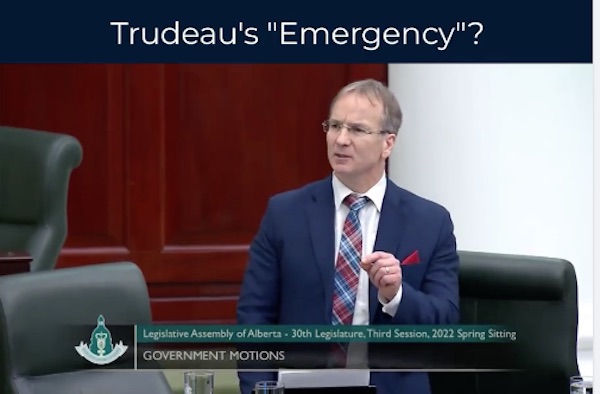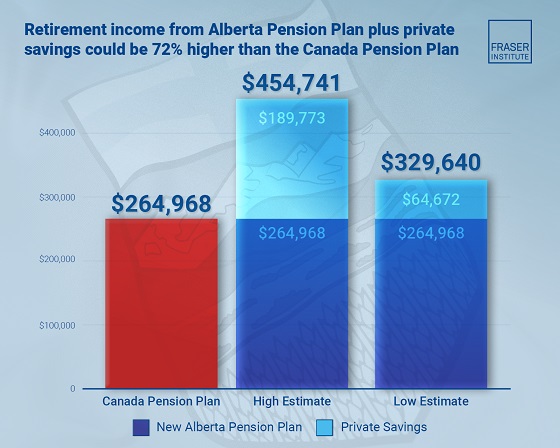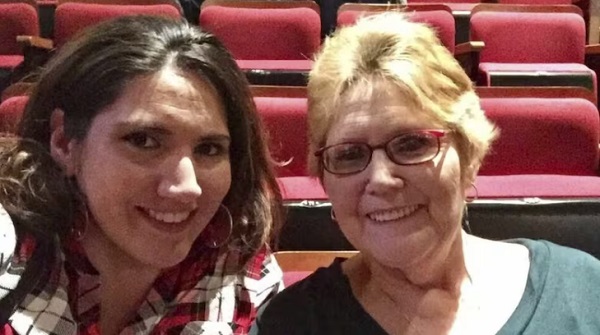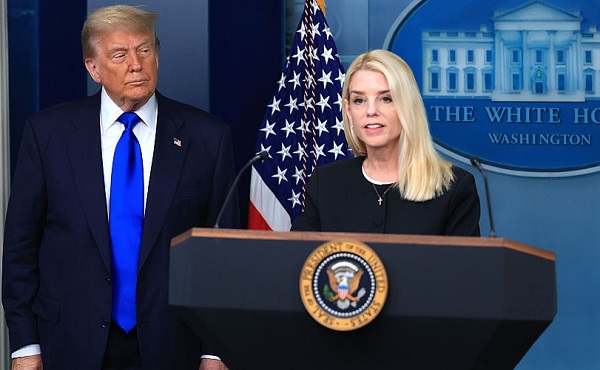Alberta
MLA says Trudeau’s “Emergency” underlines the need for a full public inquiry into government handling of covid crisis

This article and video submitted by Red Deer South MLA Jason Stephan
As of Tuesday restrictions are substantially all gone from Alberta. Good. This is more how it should have been all along. We have seen too much top-down, command and control approach by all levels of government. I have and will continue to ask for an independent, comprehensive public inquiry. The better way is for Governments to trust adults to govern themselves and their families in respectful ways. Trudeau’s use of the Emergency Act looks increasingly ridiculous, even dangerous.
Last week the Alberta Government brought forward a motion on the Emergency Act. I stood in the legislature and the following are excerpts of my statement: (video and then written statement)
“Mr. Speaker, about a month ago I attended the Trucker Convoy Rally at Gasoline Alley. It was packed with friends. It was not an angry gathering; it was a positive atmosphere filled with hope. Why? Because men and women and families, had felt voiceless, disenfranchised by Federal and Provincial governments. But now they had a voice in a trucker convoy. That was a cause to celebrate; they did not feel listened to, they felt ignored.
I understand that feeling. I have felt it myself. We have seen a top-down, command and control approach that treated adults as children, not respecting and trusting them to govern themselves and their families in respectful ways.
Mr. Speaker what I have witnessed, offends my core values as a public servant. Mr. Speaker, many Albertans feel the same. In the end the truth will prevail, and history will show, that governments made gross errors, that across-the-board vaccine passports and mandates caused more harm than good, especially to young adults and children. Public health authorities undermined their own authority with biased reporting and using fear and coercion as a tool.
Mr. Speaker I have spoken on this before, and I will be bringing forward a motion in this legislature for there to be a comprehensive, public inquiry into COVID, including a full cost analysis of COVID restrictions, mandates and passports, especially on young adults and children. The truth must prevail. Mr. Speaker, in respect of the trucker convoy, we know what the Prime Minister did, that he went into hiding, and sought to cancel and delegitimize the protestors calling them a fringe minority, labelling them as misogynists and racists.
Now Mr. Speaker, there were a few protestors who did blockade public roads. I do not condone that. I do not believe, like some politicians in this legislature, that the ends justify the means. Even in a cause that is just, it is not right to blockade. It undermines the moral high ground of a just cause. I sorrow that it occurs. The Prime Minister enacted the Emergency Act. While he quickly revoked it, why did he do it in the first place? This was not an emergency. Yes, there were a few breaking the law, and in those isolated cases, the police should have been enforcing the laws.
This is a very serious matter. The Emergency Act must never be used as a political tool, attacking an entire movement of Canadians, including many Albertans, who felt disenfranchised, whose crime was disagreeing with government.
It labelled an entire movement which disagrees with government, as a public danger, an emergency, a voice that must be stomped out and silenced. Mr. Speaker, this is a very bad precedent. What will the government do when there is a real emergency? Will citizens need to look over their shoulders if they support causes that an insecure, unprincipled government feels threatens their power and position? Government is supposed to protect freedoms and support prosperity for its people. In many cases, they have done the opposite. There is cause for concern, turbulence is on the horizon, in some respects it is already upon us. There is an urgency to prepare.”
The truth produces hope. There is healing in the truth. The truth makes us better. In the end, the truth prevails.
Alberta
Median workers in Alberta could receive 72% more under Alberta Pension Plan compared to Canada Pension Plan

From the Fraser Institute
By Tegan Hill and Joel Emes
Moving from the CPP to a provincial pension plan would generate savings for Albertans in the form of lower contribution rates (which could be used to increase private retirement savings while receiving the same pension benefits as the CPP under the new provincial pension), finds a new study published today by the Fraser Institute, an independent, non-partisan Canadian public policy think-tank.
“Due to Alberta’s comparatively high rates of employment, higher average incomes, and younger population, Albertans would pay a lower contribution rate through a separate provincial pension plan while receiving the same benefits as under the CPP,” said Tegan Hill, director of Alberta policy at the Fraser Institute and co-author of Illustrating the Potential of an Alberta Pension Plan.
Assuming Albertans invested the savings from moving to a provincial pension plan into a private retirement account, and assuming a contribution rate of 5.85 per cent, workers earning the median income in Alberta ($53,061 in 2025) could accrue a stream of retirement payments totalling $454,741 (pre-tax)—a 71.6 per cent increase from their stream of CPP payments ($264,968).
Put differently, under the CPP, a median worker receives a total of $264,968 in retirement income over their life. If an Alberta worker saved the difference between what they pay now into the CPP and what they would pay into a new provincial plan, the income they would receive in retirement increases. If the contribution rate for the new provincial plan was 5.85 per cent—the lower of the available estimates—the increase in retirement income would total $189,773 (or an increase of 71.6 per cent).
If the contribution rate for a new Alberta pension plan was 8.21 per cent—the higher of the available estimates—a median Alberta worker would still receive an additional $64,672 in retirement income over their life, a marked increase of 24.4 per cent compared to the CPP alone.
Put differently, assuming a contribution rate of 8.21 per cent, Albertan workers earning the median income could accrue a stream of retirement payments totaling $329,640 (pre-tax) under a provincial pension plan—a 24.4 per cent increase from their stream of CPP payments.
“While the full costs and benefits of a provincial pension plan must be considered, its clear that Albertans could benefit from higher retirement payments under a provincial pension plan, compared to the CPP,” Hill said.
Illustrating the Potential of an Alberta Pension Plan
- Due to Alberta’s comparatively high rates of employment, higher average incomes, and younger population, Albertans would pay a lower contribution rate with a separate provincial pension plan, compared with the CPP, while receiving the same benefits as under the CPP.
- Put differently, moving from the CPP to a provincial pension plan would generate savings for Albertans, which could be used to increase private retirement income. This essay assesses the potential savings for Albertans of moving to a provincial pension plan. It also estimates an Albertan’s potential increase in total retirement income, if those savings were invested in a private account.
- Depending on the contribution rate used for an Alberta pension plan (APP), ranging from 5.85 to 8.2 percent, an individual earning the CPP’s yearly maximum pensionable earnings ($71,300 in 2025), would accrue a stream of retirement payments under the total APP (APP plus private retirement savings), yielding a total retirement income of between $429,524 and $584,235. This would be 22.9 to 67.1 percent higher, respectively, than their stream of CPP payments ($349,545).
- An individual earning the median income in Alberta ($53,061 in 2025), would accrue a stream of retirement payments under the total APP (APP plus private retirement savings), yielding a total retirement income of between $329,640 and $454,741, which is between 24.4 percent to 71.6 percent higher, respectively, than their stream of CPP payments ($264,968).

Joel Emes
Alberta
Alberta ban on men in women’s sports doesn’t apply to athletes from other provinces

From LifeSiteNews
Alberta’s Fairness and Safety in Sport Act bans transgender males from women’s sports within the province but cannot regulate out-of-province transgender athletes.
Alberta’s ban on gender-confused males competing in women’s sports will not apply to out-of-province athletes.
In an interview posted July 12 by the Canadian Press, Alberta Tourism and Sport Minister Andrew Boitchenko revealed that Alberta does not have the jurisdiction to regulate out-of-province, gender-confused males from competing against female athletes.
“We don’t have authority to regulate athletes from different jurisdictions,” he said in an interview.
Ministry spokeswoman Vanessa Gomez further explained that while Alberta passed legislation to protect women within their province, outside sporting organizations are bound by federal or international guidelines.
As a result, Albertan female athletes will be spared from competing against men during provincial competition but must face male competitors during inter-provincial events.
In December, Alberta passed the Fairness and Safety in Sport Act to prevent biological men who claim to be women from competing in women’s sports. The legislation will take effect on September 1 and will apply to all school boards, universities, as well as provincial sports organizations.
The move comes after studies have repeatedly revealed what almost everyone already knew was true, namely, that males have a considerable advantage over women in athletics.
Indeed, a recent study published in Sports Medicine found that a year of “transgender” hormone drugs results in “very modest changes” in the inherent strength advantages of men.
Additionally, male athletes competing in women’s sports are known to be violent, especially toward female athletes who oppose their dominance in women’s sports.
Last August, Albertan male powerlifter “Anne” Andres was suspended for six months after a slew of death threats and harassments against his female competitors.
In February, Andres ranted about why men should be able to compete in women’s competitions, calling for “the Ontario lifter” who opposes this, apparently referring to powerlifter April Hutchinson, to “die painfully.”
Interestingly, while Andres was suspended for six months for issuing death threats, Hutchinson was suspended for two years after publicly condemning him for stealing victories from women and then mocking his female competitors on social media. Her suspension was later reduced to a year.
-

 Opinion1 day ago
Opinion1 day agoPreston Manning: Three Wise Men from the East, Again
-

 Addictions1 day ago
Addictions1 day agoWhy B.C.’s new witnessed dosing guidelines are built to fail
-

 Business1 day ago
Business1 day agoCarney Liberals quietly award Pfizer, Moderna nearly $400 million for new COVID shot contracts
-

 Business1 day ago
Business1 day agoMark Carney’s Fiscal Fantasy Will Bankrupt Canada
-

 Uncategorized2 days ago
Uncategorized2 days agoCNN’s Shock Climate Polling Data Reinforces Trump’s Energy Agenda
-

 COVID-191 day ago
COVID-191 day agoTrump DOJ dismisses charges against doctor who issued fake COVID passports
-

 Alberta1 day ago
Alberta1 day agoTemporary Alberta grid limit unlikely to dampen data centre investment, analyst says
-

 Energy21 hours ago
Energy21 hours agoActivists using the courts in attempt to hijack energy policy







